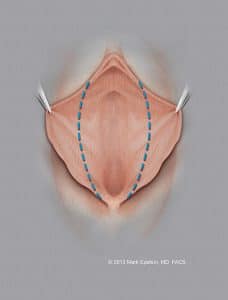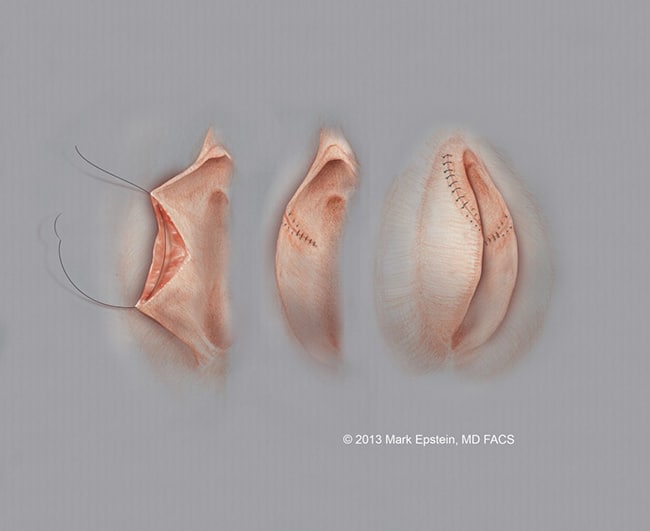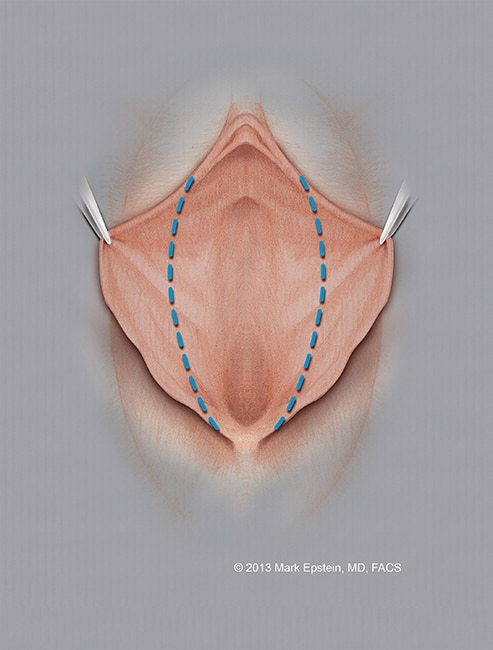
Body Procedures
Labiaplasty (Vaginal Lips Reduction)
10 Harley Street
London W1G 9PF
Labiaplasty (Vaginal Lips Reduction)
What is Labiaplasty?
Labiaplasty is a surgical procedure intended to reshape or reduce the size of the Labia Minora, that is the small inner lips situated on both sides of the vaginal opening or, less commonly, the Labia Majora, that is the larger outer lips (skin folds) of the vulva.
‘Vulva’ is the medical term that refers to the external female genitalia; it consists of the ‘mons pubis’ superiorly, the clitoris with its overlying clitoral hood, the labia majora (externally) and the labia minora (internally).
The normal variation in the anatomic arrangement of these parts is extreme and remarkable.
Indications for labiaplasty in London
Women might consider having a labiaplasty for multiple reasons ranging from discomfort experienced during sport and leisure activities to purely aesthetic reasons (that is, the mere desire for a reduction in size and improvement of symmetry).
Although there is no accepted definition of what is “normal” when it comes to the appearance of the vulva, significantly enlarged or asymmetrical labia can lead to various degrees of discomfort or embarrassment.
Oversized labia may be a cause of social embarrassment when they show through swimming costumes or tight clothing (leggings/yoga pants), or have to be continually readjusted due to discomfort. Overly large vaginal lips can, in extreme situations, become sore or suffer abrasions because of friction during sports or exercise; labia can become swollen because of excessive pressure while cycling or horseback riding. Overly elongated labia may also lead to painful sexual intercourse, when they are stretched and drawn into the vagina.
Why do labia become oversized?
The enlargement and/or asymmetry of the labia can be a congenital condition; in these cases patients often start noticing it during puberty. However, the labia can become enlarged, stretched and redundant, like many other tissues (including breasts and abdomen) due to pregnancy and childbirth, involutionary changes with ageing, and the effects of gravity over time.
Details about the procedure
The procedure can be carried out either under Local Anaesthetic (with or without sedation) or under General Anaesthesia (in this case, the patient is completely unconscious). The patient will be in the so called ‘lithotomy’ position, that is a supine position, with legs separated, flexed and supported in raised stirrups. This is the same position used for childbirth.
Because of the delicate and potentially embarrassing nature of the procedure, most patients prefer to undergo general anaesthesia.
The procedure takes about one hour and the patient is able to go home on the same day (day-case procedure), regardless of the type of anaesthetic used.
Many published techniques, aimed at decreasing the size of the labia minora, have been described. The most common two types are the ‘edge trim’ procedure and the ‘wedge resection’. The ‘edge trim’ procedure involves resecting the external/outer edges of the labia minora. With ‘wedge resection’ techniques, a simple “pie-wedge” (section) of full-thickness tissue is resected from the most protuberant/protruding portion of the labia minora, and the resulting edges are reapproximated (stitched) together.

Once the pre-operative markings are completed, local anaesthetic is injected in the area. The anaesthetic solution contains Adrenaline, which reduces the size of the blood vessels, and therefore minimizes the amount of bleeding that will inevitably occur during surgery.
If the procedure is performed with the patient under local anaesthesia, a numbing cream is applied to the area.
One dose of antibiotic is given preoperatively either by mouth or intravenously, depending on the type of anaesthesia given.
The tissue is excised using a combination of surgical blades, small surgical scissors and electrocautery.
Once the excess tissue has been excised, the bleeding is controlled with cautery forceps and the wounds are closed using fine, dissolvable stitches.
These will disappear on their own within 6 weeks. However, if – after the first couple of weeks – they cause discomfort, they can also be trimmed in the office.
The wounds take approximately two weeks to heal completely.
During these 2 weeks it is advisable to wash the genital area with an antiseptic liquid soap (antimicrobial skin wash containing chlorhexidine) and to apply an antibiotic cream locally.
The Recovery
With Miss Linda Fiumara, labiaplasty surgeon in London, the recovery is not particularly painful; patients might experience mild to minimal discomfort during the first week, mainly due to swelling and the presence of stitches. Any pain or discomfort experienced after the procedure will be controlled with effective pain-relief medication.
The treated area could be uncomfortable with excessive movement.
Patients normally can go back to work 3-7 days after the surgery.
Most of the swelling subsides within the first 8 weeks. Most patients will resume their normal activities after 6 weeks. Similarly, patients can start using tampons and have sexual intercourse 6 weeks after surgery.
Aesthetic Ideals
Studies show a wide range of sizes for each part of the female genitalia, making it extremely difficult to describe “normal measurements”.
Currently, there is no established aesthetic ideal regarding the appearance of the labia minora, although in the first description of aesthetic labiaplasty technique, Hodgkinson and Hait, in their seminal paper, suggested that labia minora protruding past the labia majora are perhaps both aesthetically and functionally unsatisfactory.
Supporting this concept, Hamori and others have argued that social trends have influenced our concepts of aesthetic ideals. The popularity of total pubic waxing, models in the media portrayed in sheer or minimal clothing with no labial show, and the anonymity of internet pornography, may contribute to a new standard of “vulval beauty”. In addition to the labia minora, the labia majora have been also scrutinized in favour of a smooth and full profile.
Although an increasing number of patients desire these evolving ideals and features, they are not universally accepted goals. Ensuring that our patients have realistic expectations is essential; we cannot promise that those media-portrayed appearances will be achieved in every patient, because of the enormous variation of anatomic presentations. Therefore, in an effort to achieve treatments that are specifically tailored for our patients, the concept of genital harmony (or proportion) as a more desired goal, is now prevailing.
Perhaps the term ‘genital harmony’ implies a more measured approach, involving discussion about balance and proportions (as in the facial aesthetic arena), rather than a media-induced aesthetic ideal.
Patients considering genital surgery should understand that the vulval complex has wide, normal anatomical variations. Although the concept of aesthetic ideal is currently evolving, however, surgical procedures should aim to genital harmony within the context of a patient’s anatomy.
Statistics about Labiaplasty in London and UK
Labiaplasty procedures are carried out both in the NHS and in the private sector.
However, labial procedures carried out for no other reason than to enhance appearance are only available privately.
According to an internet clinic search engine (whatclinic.com), the UK’s third most popular cosmetic procedure is Labiaplasty.
The company behind whatclinic.com says that they’ve seen a 109% increase in the amount of enquiries relating to labiaplasty in the course of 2016, and that it is about to become the third most sought-after surgery among women.
In 2013, the most recent year for which statistics are available, more than 5000 labiaplasties were performed in the United States, an astounding 45% increase over just one year prior.
In the UK in 2014, the NHS reported a fivefold increase in the number of labiaplasties performed over the decade prior – which doesn’t include private practice procedures, the most common kind.
In 2013, over 2000 women had labiaplasties in the NHS alone, with no figures on how many went private for similar procedures.
Labial surgery is the world’s fastest-growing cosmetic procedure.
In 2016, 45% more labiaplasty procedures were carried out than in 2015, according to data gathered by the International Society of Aesthetic Plastic Surgery (ISAPS).
Costs of Labiaplasty
The procedure costs varies depending on the complexity of the case and whether it is carried out under local or general anaesthesia.
Possible Risks of Labiaplasty Surgery
As with any surgical procedure, there is a risk of infection, bleeding and scarring.
The risk of infection is reduced by taking antibiotics and by following the postoperative instructions regarding genital hygiene.
Bleeding is normally minimal. However, it is extremely important to avoid blood-thinners (that is, aspirin, ibuprofen, anti-inflammatories, over-the-counter pain-killers) for 3 weeks prior to surgery.
Scarring is normally minimal as the mucosa and the extremely thin skin of the genital area tends to heal very nicely. Labial scars dramatically fade and soften, and are generally not detectable within 6 months for both wedge excisions and linear incisions.
Conclusions
As the popularity of female genital surgery in our practice rises, we have seen a parallel increase in published clinical experience, available operative techniques, and mounting data in the scientific literature demonstrating the physical and non-physical benefits of such procedures. We have strong evidence for high patient satisfaction, minimal complication rates, and excellent safety profiles, as well as published evidence on the psychological benefits.
For any questions, please do not hesitate to contact Miss Linda Fiumara, labiaplasty surgeon in London.
FAQ
Q. Is Labiaplasty increasingly popular?
A. Labiaplasty Is the world’s fastest growing cosmetic surgery procedure; an international study conducted by the International Society of Aesthetic Plastic Surgery (ISAPS) reveals a significant growth in Labiaplasty as more women choose to change the appearance of their genital area.
Worldwide, the number of labiaplasties performed in 2019 reached 164,667, which corresponded to a 24.1% increase compared to 2018 and a 73.3% rise compared to 2015. Labiaplasty was the 15th most popular plastic surgery procedure among female patients for 2019.
Q. Why is Labiaplasty increasingly popular?
A. Labiaplasty is a cosmetic procedure, no different than having a breast reduction or breast augmentation, that is intended to improve the quality of life for a patient.
Patients have always sought labiaplasty to improve comfort, self-confidence, and physical appearance. Rather than a media-driven desire to look a certain way, the recent increase in labiaplasty procedures is most likely due to better access: both to information about the procedure, and to the procedure itself.
Social trends have also influenced our concepts of aesthetic ideals regarding the appearance of female external genitals. The popularity of total pubic waxing/shaving, models in the media portrayed in sheer or minimal clothing with no labial show, and the anonymity of internet pornography, may contribute to a new standard of “vulval beauty”. In addition to the labia minora, the labia majora have been also scrutinized in favour of a smooth and full profile.
Q. What age demographic is getting labiaplasty?
A. Most women who get vaginal rejuvenation are between ages 20 and 60. However, there is no specific age that is considered best for receiving treatment.
While in general labiaplasty should be postponed until adulthood, in rare cases labiaplasty may be appropriate for a teenage patient; when a physical deformity of the genital tissues is causing discomfort during day-to-day activities or preventing a patient from comfortably wearing certain types of clothing labiaplasty surgery may be indicated in patients under the age of 18.
Q. What are the main reasons for people wanting to change the appearance of their vulva?
A. There are a host of reasons females have enlarged labia, including childbirth, aging, sexual activity and genetics. Women choose to have surgery for several reasons. Firstly, there are several functional benefits when electing for a labiaplasty. Many patients who suffer from enlarged labia experience difficulty with exercise, hygiene, urinary tract infections, sexual activity and other physical activities.
Furthermore, with the increasing trend of wearing yoga pants, workout pants and swimming suits, enlarged labia can make it difficult to wear such clothes. However, most female patients describe feeling extremely self-conscious when becoming romantically involved with their partners. These reasons and others are what patients consider when choosing a labiaplasty.
Q. What are the Indications for Labiaplasty?
A. Women might consider having a labiaplasty for multiple reasons ranging from discomfort experienced during sport and leisure activities to purely aesthetic reasons (that is, the mere desire for a reduction in size and improvement of symmetry).
Reasons for patients to seek labiaplasty:
- Concerns about the function of the labia tissue (length or thickness of the tissue can pinch, tug, or chafe in clothing or can cause discomfort during intercourse);
- Dissatisfaction with the appearance of the labia minora
To book a consultation call 07943 277 215 or email clinic@lindafiumara.com
Body Procedures
Labiaplasty (Vaginal Lips Reduction)
Labiaplasty (Vaginal Lips Reduction)
What is Labiaplasty?
Labiaplasty is a surgical procedure intended to reshape or reduce the size of the Labia Minora, that is the small inner lips situated on both sides of the vaginal opening or, less commonly, the Labia Majora, that is the larger outer lips (skin folds) of the vulva.
‘Vulva’ is the medical term that refers to the external female genitalia; it consists of the ‘mons pubis’ superiorly, the clitoris with its overlying clitoral hood, the labia majora (externally) and the labia minora (internally).
The normal variation in the anatomic arrangement of these parts is extreme and remarkable.
Indications for labiaplasty in London
Women might consider having a labiaplasty for multiple reasons ranging from discomfort experienced during sport and leisure activities to purely aesthetic reasons (that is, the mere desire for a reduction in size and improvement of symmetry).
Although there is no accepted definition of what is “normal” when it comes to the appearance of the vulva, significantly enlarged or asymmetrical labia can lead to various degrees of discomfort or embarrassment.
Oversized labia may be a cause of social embarrassment when they show through swimming costumes or tight clothing (leggings/yoga pants), or have to be continually readjusted due to discomfort. Overly large vaginal lips can, in extreme situations, become sore or suffer abrasions because of friction during sports or exercise; labia can become swollen because of excessive pressure while cycling or horseback riding. Overly elongated labia may also lead to painful sexual intercourse, when they are stretched and drawn into the vagina.
Why do labia become oversized?
The enlargement and/or asymmetry of the labia can be a congenital condition; in these cases patients often start noticing it during puberty. However, the labia can become enlarged, stretched and redundant, like many other tissues (including breasts and abdomen) due to pregnancy and childbirth, involutionary changes with ageing, and the effects of gravity over time.
Details about the procedure
The procedure can be carried out either under Local Anaesthetic (with or without sedation) or under General Anaesthesia (in this case, the patient is completely unconscious). The patient will be in the so called ‘lithotomy’ position, that is a supine position, with legs separated, flexed and supported in raised stirrups. This is the same position used for childbirth.
Because of the delicate and potentially embarrassing nature of the procedure, most patients prefer to undergo general anaesthesia.
The procedure takes about one hour and the patient is able to go home on the same day (day-case procedure), regardless of the type of anaesthetic used.
Many published techniques, aimed at decreasing the size of the labia minora, have been described. The most common two types are the ‘edge trim’ procedure and the ‘wedge resection’. The ‘edge trim’ procedure involves resecting the external/outer edges of the labia minora. With ‘wedge resection’ techniques, a simple “pie-wedge” (section) of full-thickness tissue is resected from the most protuberant/protruding portion of the labia minora, and the resulting edges are reapproximated (stitched) together.
The amount of skin to be removed varies widely among patients, and is mainly dictated by the anatomical features (shape and size) of the patient’s labia. In most cases a 60 % reduction in size can be achieved.
Once the pre-operative markings are completed, local anaesthetic is injected in the area. The anaesthetic solution contains Adrenaline, which reduces the size of the blood vessels, and therefore minimizes the amount of bleeding that will inevitably occur during surgery.
If the procedure is performed with the patient under local anaesthesia, a numbing cream is applied to the area.
One dose of antibiotic is given preoperatively either by mouth or intravenously, depending on the type of anaesthesia given.
The tissue is excised using a combination of surgical blades, small surgical scissors and electrocautery.
Once the excess tissue has been excised, the bleeding is controlled with cautery forceps and the wounds are closed using fine, dissolvable stitches.
These will disappear on their own within 6 weeks. However, if – after the first couple of weeks – they cause discomfort, they can also be trimmed in the office.
The wounds take approximately two weeks to heal completely.
During these 2 weeks it is advisable to wash the genital area with an antiseptic liquid soap (antimicrobial skin wash containing chlorhexidine) and to apply an antibiotic cream locally.
The Recovery
With Miss Linda Fiumara, labiaplasty surgeon in London, the recovery is not particularly painful; patients might experience mild to minimal discomfort during the first week, mainly due to swelling and the presence of stitches. Any pain or discomfort experienced after the procedure will be controlled with effective pain-relief medication.
The treated area could be uncomfortable with excessive movement.
Patients normally can go back to work 3-7 days after the surgery.
Most of the swelling subsides within the first 8 weeks. Most patients will resume their normal activities after 6 weeks. Similarly, patients can start using tampons and have sexual intercourse 6 weeks after surgery.
Aesthetic Ideals
Studies show a wide range of sizes for each part of the female genitalia, making it extremely difficult to describe “normal measurements”.
Currently, there is no established aesthetic ideal regarding the appearance of the labia minora, although in the first description of aesthetic labiaplasty technique, Hodgkinson and Hait, in their seminal paper, suggested that labia minora protruding past the labia majora are perhaps both aesthetically and functionally unsatisfactory.
Supporting this concept, Hamori and others have argued that social trends have influenced our concepts of aesthetic ideals. The popularity of total pubic waxing, models in the media portrayed in sheer or minimal clothing with no labial show, and the anonymity of internet pornography, may contribute to a new standard of “vulval beauty”. In addition to the labia minora, the labia majora have been also scrutinized in favour of a smooth and full profile.
Although an increasing number of patients desire these evolving ideals and features, they are not universally accepted goals. Ensuring that our patients have realistic expectations is essential; we cannot promise that those media-portrayed appearances will be achieved in every patient, because of the enormous variation of anatomic presentations. Therefore, in an effort to achieve treatments that are specifically tailored for our patients, the concept of genital harmony (or proportion) as a more desired goal, is now prevailing.
Perhaps the term ‘genital harmony’ implies a more measured approach, involving discussion about balance and proportions (as in the facial aesthetic arena), rather than a media-induced aesthetic ideal.
Patients considering genital surgery should understand that the vulval complex has wide, normal anatomical variations. Although the concept of aesthetic ideal is currently evolving, however, surgical procedures should aim to genital harmony within the context of a patient’s anatomy.
Statistics about Labiaplasty in London and UK
Labiaplasty procedures are carried out both in the NHS and in the private sector.
However, labial procedures carried out for no other reason than to enhance appearance are only available privately.
According to an internet clinic search engine (whatclinic.com), the UK’s third most popular cosmetic procedure is Labiaplasty.
The company behind whatclinic.com says that they’ve seen a 109% increase in the amount of enquiries relating to labiaplasty in the course of 2016, and that it is about to become the third most sought-after surgery among women.
In 2013, the most recent year for which statistics are available, more than 5000 labiaplasties were performed in the United States, an astounding 45% increase over just one year prior.
In the UK in 2014, the NHS reported a fivefold increase in the number of labiaplasties performed over the decade prior – which doesn’t include private practice procedures, the most common kind.
In 2013, over 2000 women had labiaplasties in the NHS alone, with no figures on how many went private for similar procedures.
Labial surgery is the world’s fastest-growing cosmetic procedure.
In 2016, 45% more labiaplasty procedures were carried out than in 2015, according to data gathered by the International Society of Aesthetic Plastic Surgery (ISAPS).
Costs of Labiaplasty
The procedure costs varies depending on the complexity of the case and whether it is carried out under local or general anaesthesia.
Possible Risks of Labiaplasty Surgery
As with any surgical procedure, there is a risk of infection, bleeding and scarring.
The risk of infection is reduced by taking antibiotics and by following the postoperative instructions regarding genital hygiene.
Bleeding is normally minimal. However, it is extremely important to avoid blood-thinners (that is, aspirin, ibuprofen, anti-inflammatories, over-the-counter pain-killers) for 3 weeks prior to surgery.
Scarring is normally minimal as the mucosa and the extremely thin skin of the genital area tends to heal very nicely. Labial scars dramatically fade and soften, and are generally not detectable within 6 months for both wedge excisions and linear incisions.
Conclusions
As the popularity of female genital surgery in our practice rises, we have seen a parallel increase in published clinical experience, available operative techniques, and mounting data in the scientific literature demonstrating the physical and non-physical benefits of such procedures. We have strong evidence for high patient satisfaction, minimal complication rates, and excellent safety profiles, as well as published evidence on the psychological benefits.
For any questions, please do not hesitate to contact Miss Linda Fiumara, labiaplasty surgeon in London.
FAQ
Q. Is Labiaplasty increasingly popular?
A. Labiaplasty Is the world’s fastest growing cosmetic surgery procedure; an international study conducted by the International Society of Aesthetic Plastic Surgery (ISAPS) reveals a significant growth in Labiaplasty as more women choose to change the appearance of their genital area.
Worldwide, the number of labiaplasties performed in 2019 reached 164,667, which corresponded to a 24.1% increase compared to 2018 and a 73.3% rise compared to 2015. Labiaplasty was the 15th most popular plastic surgery procedure among female patients for 2019.
Q. Why is Labiaplasty increasingly popular?
A. Labiaplasty is a cosmetic procedure, no different than having a breast reduction or breast augmentation, that is intended to improve the quality of life for a patient.
Patients have always sought labiaplasty to improve comfort, self-confidence, and physical appearance. Rather than a media-driven desire to look a certain way, the recent increase in labiaplasty procedures is most likely due to better access: both to information about the procedure, and to the procedure itself.
Social trends have also influenced our concepts of aesthetic ideals regarding the appearance of female external genitals. The popularity of total pubic waxing/shaving, models in the media portrayed in sheer or minimal clothing with no labial show, and the anonymity of internet pornography, may contribute to a new standard of “vulval beauty”. In addition to the labia minora, the labia majora have been also scrutinized in favour of a smooth and full profile.
Q. What age demographic is getting labiaplasty?
A. Most women who get vaginal rejuvenation are between ages 20 and 60. However, there is no specific age that is considered best for receiving treatment.
While in general labiaplasty should be postponed until adulthood, in rare cases labiaplasty may be appropriate for a teenage patient; when a physical deformity of the genital tissues is causing discomfort during day-to-day activities or preventing a patient from comfortably wearing certain types of clothing labiaplasty surgery may be indicated in patients under the age of 18.
Q. What are the main reasons for people wanting to change the appearance of their vulva?
A. There are a host of reasons females have enlarged labia, including childbirth, aging, sexual activity and genetics. Women choose to have surgery for several reasons. Firstly, there are several functional benefits when electing for a labiaplasty. Many patients who suffer from enlarged labia experience difficulty with exercise, hygiene, urinary tract infections, sexual activity and other physical activities.
Furthermore, with the increasing trend of wearing yoga pants, workout pants and swimming suits, enlarged labia can make it difficult to wear such clothes. However, most female patients describe feeling extremely self-conscious when becoming romantically involved with their partners. These reasons and others are what patients consider when choosing a labiaplasty.
Q. What are the Indications for Labiaplasty?
A. Women might consider having a labiaplasty for multiple reasons ranging from discomfort experienced during sport and leisure activities to purely aesthetic reasons (that is, the mere desire for a reduction in size and improvement of symmetry).
Reasons for patients to seek labiaplasty:
- Concerns about the function of the labia tissue (length or thickness of the tissue can pinch, tug, or chafe in clothing or can cause discomfort during intercourse);
- Dissatisfaction with the appearance of the labia minora
As featured in The Evening Standard and The Telegraph –










Copyright © 2023 Dr Linda Fiumara MD
Designed by Createch


